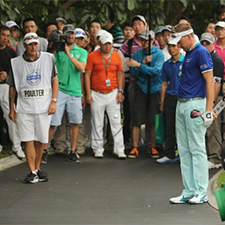In golf, you can never take anything for granted. This includes the application of the Rules of Golf. Ian Poulter learned this at the Volvo China Open this past weekend when he dropped incorrectly, resulting in additional strokes to his score. Hopefully after reading this, it will help you avoid these unnecessary penalties if you are ever in a similar situation.
The incident occurred on the thirteenth hole of his second round on Friday. Poulter hit his tee shot into some dense foliage right of the fairway. He decided that he would not be able to play the ball, so declared his ball unplayable. At that point, Poulter had three options available to him under Rule 28, Ball Unplayable. These were:
a. Proceed under stroke and distance (Rule 27-1), by playing a ball as nearly as possible to where his original ball was last played; or
b. Drop a ball behind the point where the ball lay, keeping that point directly between the hole and the spot on which the ball is dropped, with no limit to how far behind that point the ball may be dropped; or
c. Drop a ball within two club-lengths of the spot where the ball lay, but not nearer the hole.
Poulter chose to proceed under option c and did so correctly. When he dropped the ball, he dropped it on a cart path (an immovable obstruction), which was situated near the foliage from which he was taking relief. He was correct in dropping on the cart path, because the Rules do not permit him from taking relief from the cart path without first putting a ball into play by dropping it under Rule 28c (Ball Unplayable). Up to this point, he was proceeding correctly.
After taking the drop for the ball unplayable, his ball was now on the cart path, from which he did not want to play. Rule 24-2 (Immovable Obstruction) gives the player the option to take relief without penalty if he has interference from either the lie of the ball, his stance, or the area of his intended swing. Because Poulter’s ball was lying through the green, i.e. not in a hazard or on the putting green or teeing ground of the hole being played, he was entitled to lift the ball and drop it within one club-length of and not nearer the hole, than his nearest point of relief. Here’s where he got into trouble.
Instead of dropping within one club-length, he measured out two club-lengths and dropped it within the second club-length. This was outside the area in which he was permitted to drop; therefore it was a wrong place. Poulter had not yet incurred the dreaded two-stroke penalty however. He still could have corrected this mistake, if he had been informed of his error, by simply picking up the ball under Rule 20-6, and dropping it within the prescribed one club-length area.
A good principle to remember when it comes to club-lengths and dropping is: When you are receiving a penalty stroke, you are allowed two club-lengths, if the Rule permits. When you are getting free relief, you are entitled to only one club-length, if the Rule permits.
Unfortunately for Ian, no one noticed his wrong-doing at the time and he played the ball from its wrong location, resulting in a violation of Rule 24-2 and a two-stroke penalty. He ended up with a triple-bogey, 8 on the hole. After he learned of the violation, he was not mad at the Rule, he was mad at himself for making a mistake on such a seemingly simple Rule.
I guarantee Ian Poulter won’t take for granted these simple procedures anymore and neither should you.


